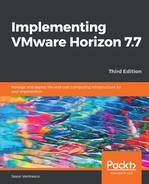There are a number of options that must be selected when creating a Horizon desktop pool. Understanding what these options mean is important, as they will impact not only on how the desktops are deployed, but also on what options users have when they attempt to access those desktops.
Later on in the chapter, we will go through the deployment of two different desktop pools, but prior to that it is important to familiarize yourself with some of the terminologies that will come up during that process. Once you understand these terms, you will be able to create any type of desktop pool, which is something we cannot demonstrate in this book, due to the sheer number of options that exist:
| Term | Definition |
| Access Group | Used to organize desktop pools within a Horizon pod, for reasons such as delegated administration. |
| Adobe Flash Settings for Sessions | Pool settings that control Adobe Flash's quality and throttling for Horizon clients, both of which affect connection bandwidth utilization. |
| Automated Desktop Pool | A pool that uses desktops provisioned using Horizon. |
| Automatic Assignment | Used with dedicated desktop assignment: If a user does not already have a desktop assigned, they will automatically be assigned a free one from the desktop pool. |
| Blackout Times | Used to set when the View Storage Accelerator and VM disk space reclamation will not run. |
| Connection Server Restrictions | Used to restrict what connection servers can be used to access a desktop pool: commonly used to assign pools to a connection server that has specific security settings. |
| Dedicated (assignment) | A desktop from the pool is assigned to a user, and from then on it is available only to that user, unless the assignment is manually removed. |
| Desktop Pool ID | The unique identifier for a desktop pool within a Horizon pod. |
| Display Name | The desktop pool name that will be displayed in the Horizon Client login window. |
| Disposable File Redirection | Used with a linked clone desktop to redirect disposable files to a non-persistent disk rather than the OS disk. |
| Floating (assignment) | Desktops are not assigned to any one user; if they are not in use, they are available to anyone that is entitled to access the desktop pool. |
| Full Virtual Machines (desktops) | Full virtual machine clones of a vCenter template created from the virtual desktop master image. |
| Guest Customization | The process of preparing a Horizon desktop for placement within an Active Directory domain. |
| Instant Clones | Instant Clone desktops share the same base virtual desktop master image as linked clones but can only be deployed using floating assignment pools. After every logoff, Instant Clone desktops are rapidly recreated using vSphere VMFork technology. |
| Manual Desktop Pool | A pool that uses desktops that already exist within vCenter, such as those configured using storage array-based cloning technologies. |
| Naming Pattern | Used by Horizon to generate names for the virtual machines that it creates. |
| Non-Persistent Disk | Optional part of a Horizon Composer-linked clone desktop: Used to store disposable files that will be deleted automatically when the user's session ends. |
| Persistent Disk | Optional part of a Horizon Composer-linked clone desktop: Used to retain user profile data during a Horizon Composer refresh, recompose, or rebalance operation. |
| QuickPrep | Similar to Microsoft Sysprep; optional method offered by Horizon for customizing and then joining linked clone desktops to an Active Directory domain. |
| Reclaim VM Disk Space | Reclaims blocks that are no longer being used by the virtual machine operating system. |
| Replica Disk | Part of a Horizon Composer-linked clone desktop; the replica disk is a read-only copy of the virtual desktop master image virtual hard disk that is shared among the desktops in the pool. |
| Storage Overcommit | Determines how Horizon places new VM on selected data stores. The more aggressive the setting, the more VM Horizon will place on the data store while reserving less space for sparse disk growth. Refer to the Horizon documentation (https://docs.vmware.com/en/VMware-Horizon-7/index.html) for specific details about the available overcommit levels. |
| RDS Desktop Pool | A pool that provides access to Windows RDS servers, which are typically used to host multiple simultaneous Horizon client sessions. |
| Transparent Page-Sharing Scope | Defines the level at which to allow Transparent Page Sharing (TPS), which frees up redundant memory pages on an ESXi host. Valid options are Pool, Pod, or Global. |
| Use Native NFS Snapshots (VAAI) | This feature eliminates the need for the ESXi servers to read and write data during the creation of Horizon Composer-linked clones by using the built-in capabilities of the storage array to create the virtual machines. |
| View Composer-Linked Clones | Clones of a virtual desktop master image that share the same base disk. Changes to linked clone desktops are written to a dedicated virtual hard disk attached to the linked clone virtual machine. |
| View Storage Accelerator | Uses up to 2 GB of ESXi server RAM to cache frequently used blocks of virtual desktop data. |
| VM Folder Location | The location where Horizon will place the virtual machines it creates in the vCenter VM and Templates view. |
